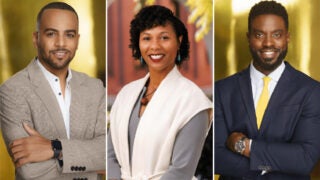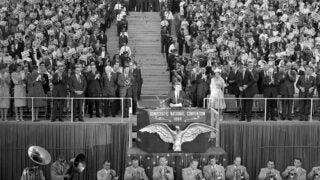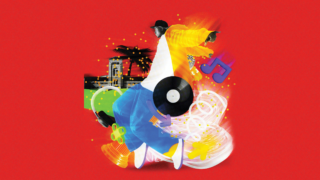How to Teach Against Hate? Lean on Genocide Survivors
Learning from eyewitnesses of some of history’s darkest moments, educators strive to teach the power of decency and respect.
The 2018 Winter Olympics were in full swing and the students in Ivy Schamis’ high school classroom were upbeat. The teacher was guiding the students in her Holocaust history class through a discussion about the 1936 Summer Games. She described how a German man had given famed black track athlete Jesse Owens a pair of specially designed running shoes despite risk of repercussions from the Nazi government.
“Does anybody know who that man was?” Schamis asked. A young man raised his hand. For the first time Schamis could remember, a student knew the answer. The shoemaker was Adi Dassler, the founder of Adidas, 17-year-old Nicholas Dworet said proudly.
Gunfire rang out, one bullet after another. Someone was firing into the classroom. “We just flew out of our seats and tried to take cover,” Schamis says, “but there was nowhere to hide.” Two minutes later, Dworet and another student, named Helena Ramsay, also 17, were killed by gunfire. They were among the 17 students slain on Feb. 14, 2018, in the tragic shooting at Marjory Stoneman Douglas High School in Parkland, Florida.
Schamis had been using lessons and activities from an educational program called IWitness as a way to counter the kind of hatred and violence that struck her classroom that day. IWitness is a cornerstone of USC Shoah Foundation—The Institute for Visual History and Education’s efforts to teach empathy and respect. It was created to show, through the example of genocide survivors and witnesses, that human beings need to be ethical, empowered, decent and kind.
Or, to use modern parlance, to be upstanders.
It may seem ironic that a classroom dedicated to embracing cross-cultural understanding would be visited upon by such senseless violence. But it was that kind of violence that prompted Schamis to delve into the topic with her students in the first place.
“The lessons of the Holocaust came right into Room 1214 that day,” Schamis says.
Teaching tolerance through survival
Introduced in 2012, IWitness is a free, web-based program that offers curated clips from the more than 55,000 witness testimonies in the institute’s Visual History Archive. They’ve vital resources in teaching tolerance.
Housed at USC Shoah Foundation, each recording is a firsthand account from a person who experienced some of humanity’s darkest moments. The Holocaust, genocides in Armenia, Rwanda, Guatemala, Cambodia, South Sudan and the Central African Republic, and the Nanjing Massacre are all represented. The institute also collects testimony chronicling contemporary acts of anti-Semitism. But its mission isn’t to use these stories for academic research. Instead, it wants as many people as possible to hear and share these stories in classrooms, community centers and homes around the world.
Students learning through the IWitness program watch a piece of testimony and then are assigned a variety of activities that align with teaching standards. These assignments might include creating multimedia projects that integrate testimony clips together with footage from other sources, as well as photographs and maps, music and text. Teachers use the program in all 50 states and in 83 countries around the world.
For teachers like Schamis, the program offers an important and compelling way to broach difficult subjects, such as propaganda, Jim Crow laws and how to challenge extremism. “There’s nothing like listening to testimony,” she says. “We have Holocaust survivors in South Florida, but many can’t get to our school. This is the next best thing. It’s amazing.”
And she has seen results. After the shooting, many of her IWitness students have become national spokespeople in the debate over gun laws. While some Americans might disagree with the policies the students endorse, these young people chose to step forward to argue for what they believe in, instead of stepping aside.
“I asked Ivy if she was surprised that her students stepped into this role,” says Stephen D. Smith, the Finci-Viterbi Endowed Executive Director at USC Shoah Foundation. “She said, ‘No, that’s why we teach what we teach: to ready people to be participants in the world.’ Her perspective as a teacher is not on gun control itself, but about preparing students to take a position and argue for that based on a set of values they believe in.”
USC Shoah Foundation aims to be ‘stronger than hate’
The tragedy in Florida was the latest in a series of events that had a strong impact on USC Shoah Foundation.
In the months leading to the 2016 U.S. presidential election, the institute’s staff had grown increasingly concerned about the uncivil tone of discourse in the country.
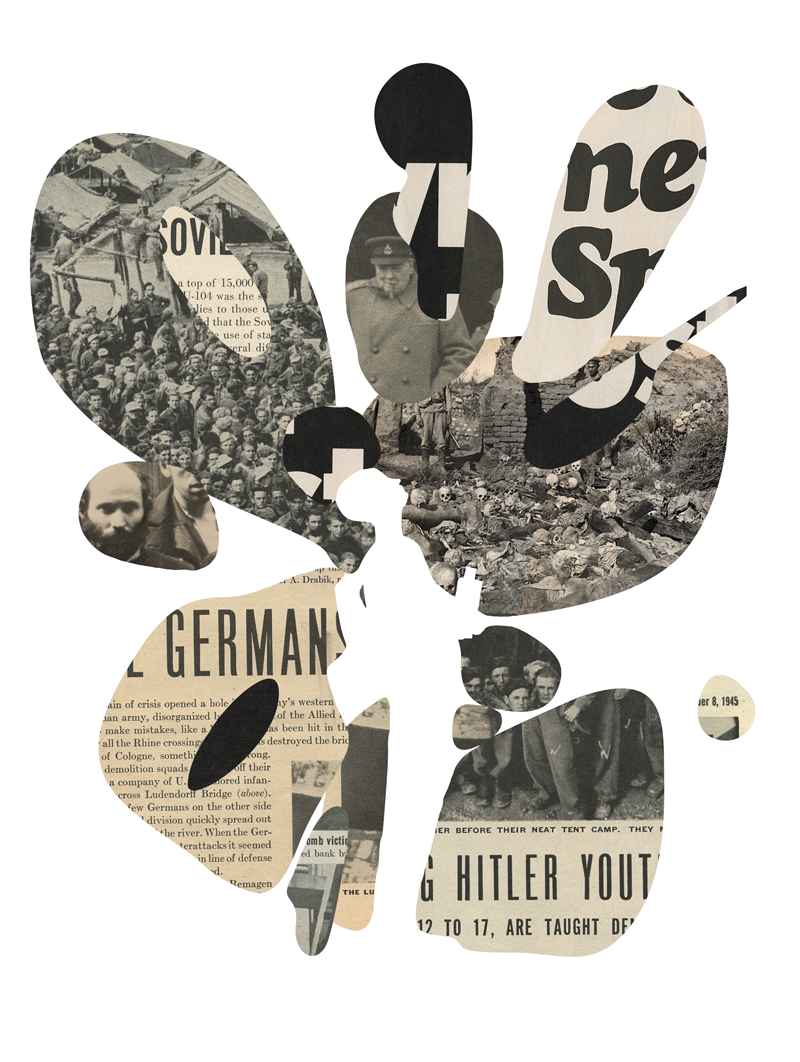
“Having differing points of view is a valuable thing,” Smith says. “But we have not found the space to argue with each other respectfully. We are talking to our own communities about things we agree on. Our concern at USC Shoah Foundation is not about the political spectrum. Our concern is about people’s values and how they’re prepared to apply them.”
To help stave off the wave of vitriol and misunderstanding, USC Shoah Foundation developed an ambitious new project. Borrowing from a tradition started at the beginning of Franklin D. Roosevelt’s presidency in 1933, the “100 Days to Inspire Respect” campaign was designed to encourage discussion and empathy, regardless of who won the election.
Starting in January 2017, the institute’s education department released a new IWitness activity every day focused on secondary school students. The tolerance education program offered lessons on topics related to current issues, as well as lessons about respectful conversation, how to manage different viewpoints and critical thinking in the media.
“The 100 Days to Inspire Respect demonstrated that the use of testimony across the curriculum was possible and indeed needed by teachers to address the context in which we found ourselves,” says Claudia Ramirez Wiedeman, director of education at USC Shoah Foundation. “And we could do so in a flexible way that could meet teachers’ needs around the world.”
Within months, violent public protests offered a new opportunity for tolerance education. On Aug. 11, 2017, a group of neo-Nazis and white supremacists marched through the streets of Charlottesville, Virginia, carrying swastikas and chanting anti-Semitic slogans. The marchers clashed with protestors, one of whom was killed.
“The events in Charlottesville gave us pause, not only because of the language, the violence and the killing that took place on American soil,” Smith says. “We saw a coherence. They actually cohered around one thing: anti-Semitism. It was an attack against Jews living in America.” The response by the institute was the “Stronger Than Hate” initiative, which serves as a rallying cry to uphold the values of openness, respect, dignity and human rights.
“There will always be hatred, prejudice and violence against what some self-ordained majority or supremacist says about another group,” Smith says. “I don’t think we’ll ever see the end of this dark side of our humanity. However, we can create the kind of community and values that will be stronger than the hatred we know we will face.
“At places like USC Shoah Foundation and USC, we should be creating this space for vigorous debate and not be afraid of other points of view. Fear is a generator of hatred. To counter that, we can teach how to be civil even when it feels like circumstances are deteriorating.”
To create the campaign, the institute turned again to its strongest resource: the voices of genocide survivors.
“The testimonies exist because somebody experienced hatred at the hands of others,” Smith says. “But the interviewees themselves virtually never propose another form of hatred as an answer to what they went through. You never hear, ‘I was hated, therefore I hate.’”
Can education truly instill decency and respect, and do the actions of individuals matter in fighting hate? Vigorous evaluations and studies conducted by the institute provide reason for hope. USC Shoah Foundation research has shown that 78 percent of students recognized that one person can make a difference if they see an example of stereotyping against a group of people. Another 78 percent believe it’s important to speak up against stereotyping when they see it around them.
“If we have racist and anti-Semitic ideologies coming at us, then we can develop in students the skills, knowledge, abilities and capacities to counter those ideologies, make better decisions and be more active in opposing those ideologies as citizens,” Wiedeman says.
Wiedeman and USC Shoah Foundation aren’t alone in believing that empathy, openness and tolerance can be taught. Shaun R. Harper, executive director of the USC Race and Equity Center, says it’s possible to make the intolerant more tolerant.
“Hate can be unlearned,” Harper says, “but we have to have the curricular space for it. It’s like a foreign language. The younger you are, the easier it is to learn a foreign language. The same thing is true for unlearning and learning hate. If we can get to people early, we can help them through forms of consciousness-raising.”
One way to reach into hearts and minds is by witnessing and understanding historical examples of hatred and shared humanity. They provide opportunities for introspection and questioning. Jody Armour, the Roy P. Crocker Professor at the USC Gould School of Law, has devoted much of his career to studying issues of racism and discrimination. On a trip to Poland a few years ago, he addressed students there on prejudice and the American experience — and came away a different man after visiting several Nazi death camps during the trip.
“I stopped at Treblinka and Auschwitz with the sense of history that I had,” he says. “It transformed me. I never thought of tolerance the same way again. I never thought about the importance of ‘not forgetting’ the same way.”
Armour says that the keys to changing outlooks for the better are being honest about one’s own shortcomings and vigilant in ensuring a brighter future. “There’s something very uncomfortable about being truthful, about having a looking glass that allows us to gaze at our own reflection,” he says. “It doesn’t mean we have to be pessimistic or cynical. It’s always been the case in the American experience that people had to struggle for freedom and justice. Inclusion and equality are things every generation has to fight for.”
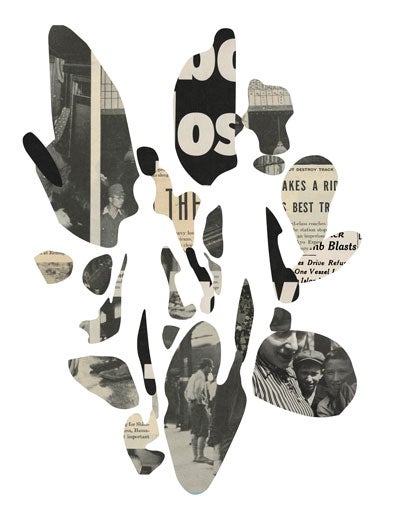
The past is the present
In recent years, USC Shoah Foundation has ramped up its efforts to share the lessons of genocide through innovative and emerging technologies. The groundbreaking Dimensions in Testimony project offers people the opportunity to stand face to face (virtually) with a survivor and have a conversation. It’s a powerful experience that helps make the past relevant to people today.
Working with the USC Institute of Creative Technologies and Conscience Display, a company specializing in interactive storytelling, the institute filmed high-definition 3D recordings of survivors answering thousands of questions. Using advanced language- recognition software, Dimensions in Testimony provides a way for a viewer to ask any question to survivors and instantly receive a prerecorded response. So far, 17 interviews have been conducted, most in English, with other languages in development. One permanent display is on view at the Illinois Holocaust Museum and Education Center. Another featuring a survivor of the 1937 Nanjing Massacre is on permanent display at the Nanjing Massacre Memorial Hall in China.
The institute has also developed an immersive virtual reality experience that brings life in a Nazi death camp into sharp focus. Called “The Last Goodbye,” the short, room-scale film takes viewers through the Majdanek concentration camp while a projection of Holocaust survivor Pinchas Gutter narrates the experience. Gutter, who lost his parents and twin sister at Majdanek, was also the first person to be interviewed for Dimensions in Testimony. He has long been an advocate of teaching the lessons of the Holocaust.
“I tell my story for the purpose of improving humanity, drop by drop by drop,” Gutter says. “Like a drop of water falls on a stone and erodes it, so, hopefully, by telling my story over and over again, I will achieve the purpose of making the world a better place to live in.”
To bring messages of tolerance to children, the institute released Lala, a virtual-reality film and educational resource that tells the true story of a dog that brightened the lives of a family interned in a ghetto in Poland during the Holocaust.
“Exposing younger learners to the realities of genocidal violence is something we have to do very carefully,” Smith says. “The story of a dog is one that’s universal and relatable. They may not know about the Second World War and Nazis and Jewish communities, but one thing they do know about is what it means to be separated from a pet.”
While pioneering technology like virtual reality and 3D projections have garnered buzz and awards, institute staff know these tools are simply the means of spreading their message. The core mission remains on witness testimonies and their power to teach, empower and inspire hope for greater understanding. Florida high school teacher Ivy Schamis says that despite the shooting in her classroom, she remains undaunted in her quest to spread a belief in shared human values. She’s more eager than ever to teach students the lessons of the Holocaust.
“Hate is never OK. Tell everybody,” she says. “We have to be there for each other.”

